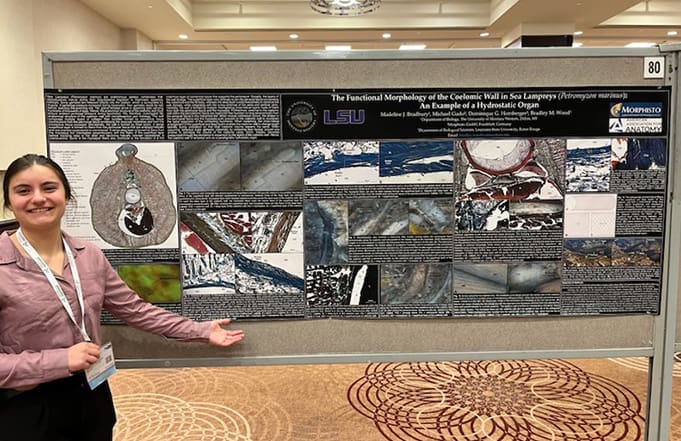June 26, 2024
University of Montana Western biology major, Madeline Bradbury, recently presented her original research on the anatomy of sea lampreys at the American Association for Anatomy (AAA) annual meeting in Toronto, Canada.

Bradbury worked with Dr. Bradley Wood, UMW Associate Professor of Biology, to investigate the structure and function of the coelomic wall in sea lampreys (Petromyzon marinus) to better understand the fundamental construction of the abdominal wall in vertebrates and its role in pressure regulation. She performed microdissections and examined histology slides under Dr. Wood’s guidance.
The key findings of her research showed that the coelomic wall in sea lampreys acts as a hydrostatic organ, and its structure is critical in maintaining ambient pressure within the coelom. It has a three-layered structure with helical fiber arrangements, crucial for maintaining internal pressure. During muscle contraction and swimming, the wall’s arrangement allows for volume stability and lateral length changes. During spawning, body contortions decrease coelomic cavity volume, pressurizing it to expel gametes. This structure is essential for maintaining ambient pressure within the coelom.
These findings illustrate that, similar to sea lampreys, the three-layered orientation of muscle fibers in the human abdominal wall is crucial for selective coelom pressurization. In vertebrates, this orientation facilitates pressure regulation. Unlike vertebrates, lampreys cannot selectively pressurize their coelom and must use mating behaviors to achieve coelom pressurization for gamete release. Bradbury explained that this research was preliminary and that there are several avenues still to explore, including establishing a more direct evolutionary relationship between the abdominal wall in vertebrates and sea lampreys and investigating specific human ailments, such as issues in women’s pelvic floor and peritoneal pressure regulation.
Besides facing technical issues, Bradbury said time and workload management proved to be significant challenges while conducting this undergraduate research. She often spent early mornings before class and late nights after work in the lab. However, all this time and hard work is now paying off. Bradbury’s research abstract from the AAA meeting was published in the June 2024 issue of “The Anatomical Record” (page 44).
“I didn’t expect this research to be published when I started this project, but I’m extremely proud of the time and work I put in and the findings I was able to uncover,” she said.
Bradbury also expressed that Dr. Wood’s expertise and guidance were instrumental in the success of the research and that she was grateful to collaborate on such a project with him.
“Dr. Wood and I met weekly to discuss developments in the research and explore the function of the anatomical structures discovered. As an expert in lamprey biology, Dr. Wood answered questions and supported me throughout the process,” said Bradbury.
Looking ahead, Bradbury is enthusiastic about continuing research related to human medicine, with a particular interest in degenerative disorders and surgical techniques. This summer, she will attend the Neurological Surgery Student Summer Program, which she hopes will open various MD/PhD pathways and career opportunities. Post-graduation next spring, she plans to attend medical school, with aspirations to explore specialties in surgery and anesthesia while continuing her research as an MD/PhD student.
Reflecting on her education at UMW, Bradbury explained that the Biology Department and block schedule were crucial to her success as an undergraduate and have helped prepare her as she continues her academic journey.
“UMW has cultivated a community of driven individuals within the Biology Department that provides students with hands-on opportunities and sets a high standard of academic excellence. The block schedule at UMW encourages students to develop time management skills rapidly while working in a fast-paced environment. The skills I learned at UMW will help me manage intense academic standards in medical school,” she said.
For UMW students interested in pursuing undergraduate research in biology or a related field, Bradbury suggests exploring options early and developing a plan to manage the potential workload that comes with it.
“Start exploring your options early and discuss your interests with professors and advisors around you—they are here to help. I would encourage students to create a support system of peers and professors early to help navigate the challenges. Also, find a hobby. It is easy to get consumed in the research, so it is important to have a creative outlet to avoid burnout,” she said.
For more information about opportunities for undergraduate research and the premedical program at Montana Western, please contact Dr. Mike Morrow, Professor and Chair of the Biology Department, at [email protected].